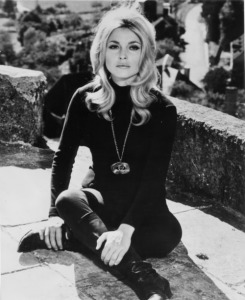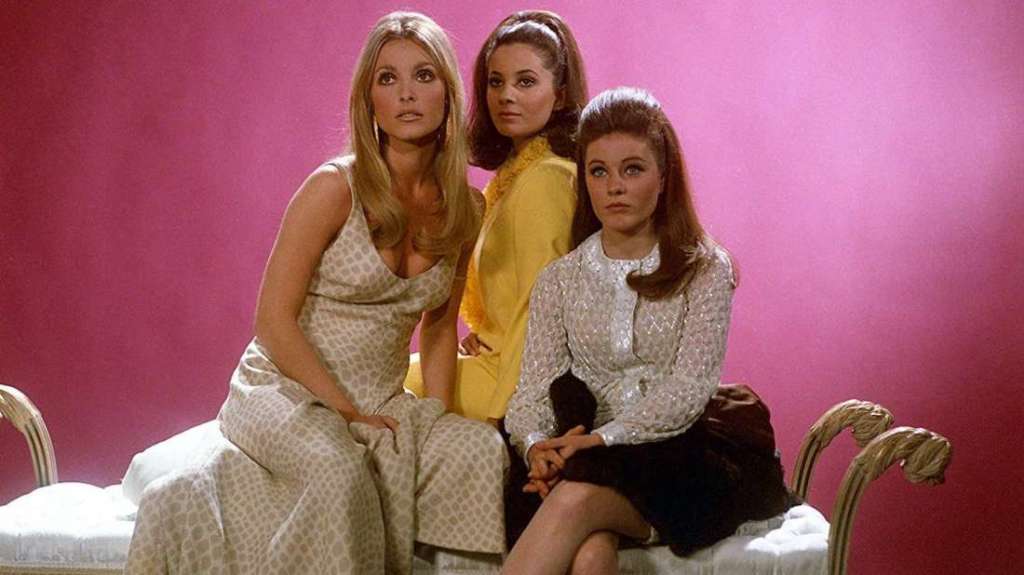In advance of Ian Cooper’s Miskatonic London class “No Sense Makes Sense: Gurus, Cults, Movies and Murder,” on May 17th, Martyn Conterio looks back at the onscreen legacy of Sharon Tate
Novelist and film writer Gilbert Adair pondered the screen paradox of watching old movies and performers in them, in an entry of his 1996 book, Flickers. The camera and celluloid conspire to capture moments, contains them, even traps them, to be watched over and over again, yet time in reality has moved on and many of the people we watch on the screen passed long ago. He or she is dead and he or she is going to die. When it comes to Sharon Tate, this paradox of the movies is leant a ghoulish frisson. While many movie stars, starlets and wannabes met tragic deaths in Hollywood, Tate’s was elevated in pop culture to represent the end of an era and was tied to another narrative – the calamitous story of the Manson Family cult.
 Crime scene photos from Cielo Drive – Tate, with a noose-style rope draped around her neck, wearing only bra and underwear, as there was a heatwave in the city at the time, saturated in blood from 16 stab wounds – are harrowing. 49 years on, the image of Tate we are left with in pop culture is limited and morbid – murder victim, counter culture martyr. Yet in recent times, too, Tate’s 1960s It Girl persona has influenced and inspired fashion designers, and there has been an attempt to rehabilitate, or rather, alter the abiding image we have of her – moving away from the association with Charlie Manson to something more positive.
Crime scene photos from Cielo Drive – Tate, with a noose-style rope draped around her neck, wearing only bra and underwear, as there was a heatwave in the city at the time, saturated in blood from 16 stab wounds – are harrowing. 49 years on, the image of Tate we are left with in pop culture is limited and morbid – murder victim, counter culture martyr. Yet in recent times, too, Tate’s 1960s It Girl persona has influenced and inspired fashion designers, and there has been an attempt to rehabilitate, or rather, alter the abiding image we have of her – moving away from the association with Charlie Manson to something more positive.
She appeared in six credited feature films and shared screen time with Vittorio De Sica, David Niven, Claudia Cardinale, Deborah Kerr, Vittorio Gassman Tony Curtis and Roman Polanski (who became her husband). While it is difficult to assess what talent she had, or even simply watching these movies, without the event at Cielo Drive serving as a constant reminder, Tate might well have found a niche in horror flicks and comedies. There’s something about Tate which harks back to the silent era comediennes, too. She might have been a Clara Bow for the sixties. Vivacious, incredibly beautiful but with an approachable girl next door quality, self-aware and funny in a peculiar deadpan-like way, Tate worked with the image assigned to her by men in charge of her career, but she wasn’t Valley of the Dolls’ Jennifer North in real life – the talentless starlet who commits suicide – however much the comparison might be tempting to make.
Making her debut playing a witch in Eye of the Devil, with a femme fatale allure to match Barbara Steele’s in Black Sunday (1960), only The Fearless Vampire Killers used Tate’s stunning looks to any ironic effect. So enchanted and besotted with Sarah (Tate) is hapless vampire hunter Alfred (Polanski), he fails to realise she’s turned into the undead and is about to kill him. In Don’t Make Waves (1967), directed by Alexander McKendrick, Tate was cast as Malibu, a sky-diving surfer who captures Tony Curtis’ eye. Honey-haired, bronzed and cooly aloof, Tate played up beach bombshell in amusing fashion. In what turned out to be her last film, The Thirteen Chairs, released posthumously, she shared a very funny scene with Terry-Thomas, where his antiques removals van driver relates to her the increasingly filthy, transgressive details of a smutty novel he’s reading. Parting ways, he asks her if she wants to borrow the book, and Tate’s disinterested character deadpans: “I’ll wait for the movie.”
Her films are generally ignored today, bar The Fearless Vampire Killers, the film which turned her into a doomed icon for cinephile veneration, though Eye of the Devil and Don’t Make Waves fall under the category of ‘hidden gems’. Valley of the Dolls, of course, is a camp classic and probably always will be.



